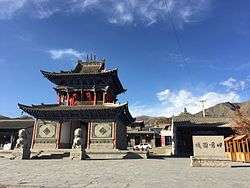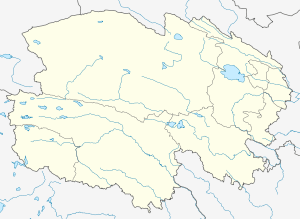Chengguan, Huangyuan County
| Chengguan 城关镇 | |
|---|---|
| Town | |
 Dan Gar Ancient Town | |
 Chengguan Location in Qinghai and China | |
| Coordinates: 36°41′17″N 101°15′28″E / 36.68806°N 101.25778°ECoordinates: 36°41′17″N 101°15′28″E / 36.68806°N 101.25778°E | |
| Country | People's Republic of China |
| Province | Qinghai |
| Prefecture | Xining |
| County | Huangyuan |
| Population (2010)[1] | |
| • Total | 43,871 |
| Time zone | UTC+8 (China Standard) |
Chengguan Town (Chinese: 城关镇; pinyin: Chéngguān zhèn) is the county seat of Huangyuan County in Qinghai, China. The town is approximately 45 km (28 mi) upstream (west) from the provincial capital of Xining on the Huangshui River, and approximately 45 km (28 mi) east of Qinghai Lake.[2] As the county seat, the town is often referred to as Huangyuan in English-language publications. Historically a frontier trading post, Chengguan has a 600-year history of Chinese, Mongolian, and Tibetan cultural interactions. The Mongolian name for the town was Dan Gar and the Tibetan name for the town was Tongkor.
Chengguan Town is the site of Dan Gar Ancient Town (Chinese: 丹噶尔古城; pinyin: Dāngáěr gǔchéng), now a tourist attraction.
History
The American adventurer and diplomat, W. W. Rockhill, referred to the town in 1891 as Tankar (Tan-ka-erh), but adds this note:
"Huc calls it Tang-keou-eul and Prjevalsky calls it Tonkir or Donkir. Tibetans and Mongols name it Dung kor or Tung kor. The name is not Chinese: it may be t'ang mk'ar "fort (commanding) the steppe," if it is a Tibetan name, of which I am not sure."[3]
Rockhill reports that late in the 19th century there was a massacre of nearly 10,000 Muslims around the town of "Tankar", but there were still "not more" than 10,000 Chinese and Tibetans in the town; with a "nominal force of 200 men under a colonel". Muslims were no longer allowed entry.[4]
The town was walled and was an important trade centre. The journey from Tongkor to Lhasa was usually sixty to seventy days.[5] Rockhill mentions that its importance as a trade centre had diminished since the recent war.[6]
Items brought from Lhasa included woolen cloth of various colours and qualities, incense sticks, the best quality K'a ch'é shakama saffron from Kashmir, Buddhist books, dried dates and brown sugar from India, cowries, disks of chank-shells and amber for ornaments, furs and a few other items. Among the most valuable items brought by Tibetans or, more frequently, Nepalese, are conch shells with their whorls turning to the right. They are highly valued and used in the monasteries as trumpets (Tib. Yä-chyil dung-kar) and are classed among the jewels. One of them could sell for from four to five hundred taels. The Chinese also placed a high value on them. A few traders from Khotan and Kashgar visited each year, usually in the autumn, bringing Khotan rugs, Hami raisins, dried melons and a few other things of little value. The exports contain goods of much higher value, including mules and horses, satin, silks and gold brocades, chinaware, and so on.[7]
References
- Rockhill, William Woodville (1891). The Land of the Lamas: Notes of a Journey Through China, Mongolia and Tibet. China: Century Company.
Footnotes
- ↑ "Chéngguān Zhèn". City Population. Thomas Brinkhoff. Retrieved 27 August 2017.
- ↑ Atlas of China. Beijing, China: SinoMaps Press. 2006. ISBN 9787503141782.
- ↑ Rockhill (1891), p. 109, n. 2.
- ↑ Rockhill (1891), p. 109.
- ↑ Rockhill (1891), pp. 133-134.
- ↑ Rockhill (1891), p. 110.
- ↑ Rockhill (1891), pp. 110-1111.